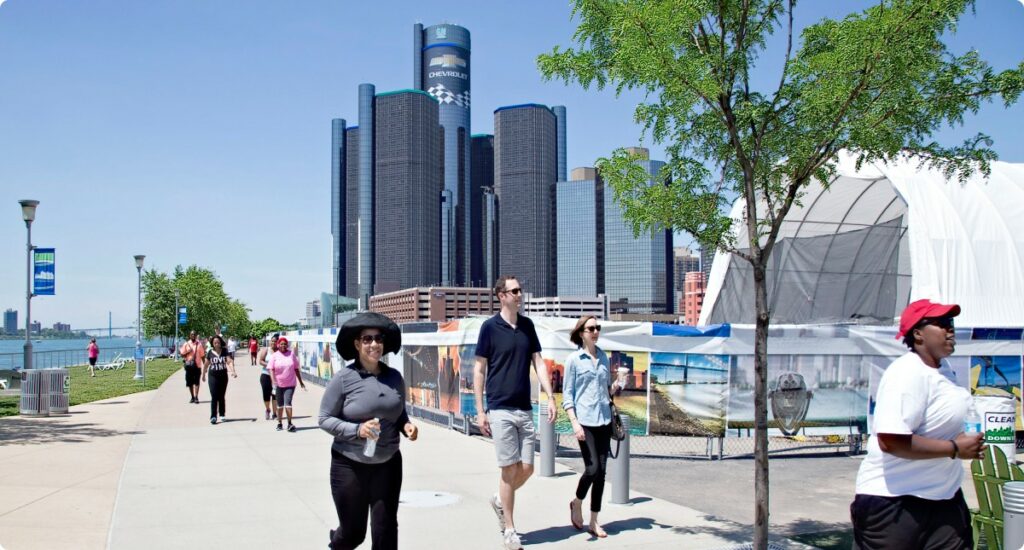From the very first grant, our hometown remains a focus and a calling.
When was this Program officially established?
Kresge’s engagement with Detroit increased markedly with the creation of the Detroit Initiative in 1993. Notable investments that followed included $50 million to launch the Detroit Riverfront Conservancy and Riverwalk. The Detroit Program formally began in 2006 with a broader mandate to support organizations and initiatives that would help revitalize Detroit and improve the quality of life for its residents.


When was this Program officially established?
Kresge’s engagement with Detroit increased markedly with the creation of the Detroit Initiative in 1993. Notable investments that followed included $50 million to launch the Detroit Riverfront Conservancy and Riverwalk. The Detroit Program formally began in 2006 with a broader mandate to support organizations and initiatives that would help revitalize Detroit and improve the quality of life for its residents.
What is an example of an early grant in this space?
Community Foundation for Southeast Michigan, $5 million, 2007
A year after the Detroit Program formally began, Kresge helped establish the New Economy Initiative (NEI), a $100 million funder collaborative to transform the Detroit regional economy through talent, innovation, culture change. A special project of the Community Foundation for Southeast Michigan, NEI continues today with a focus on transforming the city’s entrepreneurial ecosystem through investments in underserved small businesses.
Why has this area been historically important to Kresge?

“Detroit has been, and continues to be, important to Kresge for a variety of reasons,” says Wendy Lewis Jackson, managing director of Kresge’s Detroit Program. “Detroit is where Kresge was founded almost 100 years ago, and where the S.S. Kresge Company began 25 years before that. Detroit is the core — economically, socially, culturally — of a metro area vital to the state of Michigan, the upper Midwest and, ultimately, the nation. Detroit is an embodiment of aspirations and struggles of people — particularly for African Americans and others in the working class — looking for a middle-class quality of life. And Detroit is where we will find out whether those dreams have purchase in the 21st century.”
How do the current strategies reflect or build on our historical investments in this area?
While the city’s revitalization remains the focus, as it was at the program’s inception, since 2016 Kresge has pivoted to the neighborhoods, which it affectionately refers to as “the soul of the city.” It is imperative that the ongoing revitalization of Detroit’s downtown and Midtown must also embrace the city’s neighborhoods in an equitable manner.


Q: Why has this area been historically important to Kresge?
(Quote from an MD, Rip or former Kresge employee)
Lorem ipsum dolor sit amet, consectetuer adipiscing elit. Aenean commodo ligula eget dolor. Aenean massa. Cum sociis natoque penatibus et magnis dis parturient montes, nascetur ridiculus mus. Donec quam felis, ultricies nec, pellentesque eu, pretium quis, sem. Nulla consequat massa quis enim. Donec pede justo, fringilla vel, aliquet nec, vulputate eget, arcu. In enim justo, rhoncus ut, imperdiet
Q: How do the current strategies reflect or build on our historical investments in this area?
(Quote from an MD, Rip or former Kresge employee)
Lorem ipsum dolor sit amet, consectetuer adipiscing elit. Aenean commodo ligula eget dolor. Aenean massa. Cum sociis natoque penatibus et magnis dis parturient montes, nascetur ridiculus mus.
How far back can you trace work related to this program?
The foundation’s exploration of using non-grant forms of capital to advance its mission began in 2008. That year Kresge made its first five social investments, all loans between $1 million to $2.5 million.
Then in 2009, the foundation responded further to the financial crisis by issuing more than a dozen no-interest loans to nonprofits directly involved in stabilizing and supporting communities.
“Like so many things, the origins of the Social Investment Practice had its roots in crisis,” said Kresge Trustee Jim Bildner, who was instrumental in moving Kresge to begin using these tools in its work. “2008 was a profound moment for our country and for vulnerable populations. The impact of the fiscal crisis hit every element of the preexisting safety net. This created an enormous supply and demand problem that the foundation had not seen since the Great Depression.”
“The idea to make these no-interest loans came from the Trustees themselves, which was rare,” said Bildner, “and took less than 30 days from idea to reality.”
Q: When was this Program officially established? (Year and short explainer)
In 2012, Kresge hired its first managing director of social investments, Kimberlee Cornett. In 2015, the foundation expanded this area of work with a $350 million commitment – representing 10% of its corpus at that time – to deploy into impact investing.

Q: What’s an example of an early investment in this space?
IFF, $2.5 million, 2008
This 3% interest loan was paired with a $500,000 grant and supported IFF, a Community Development Financial Institution that provides below market-rate real estate loans, facilities planning and development, research projects and community planning initiatives. With the combination of a structured PRI and a grant, our support enabled the expansion of IFF's loan and advisory services out of Illinois, a critical step in expanding its ability to provide access to new sources of capital, while building IFF’s organizational capacity to sustain program operations.
